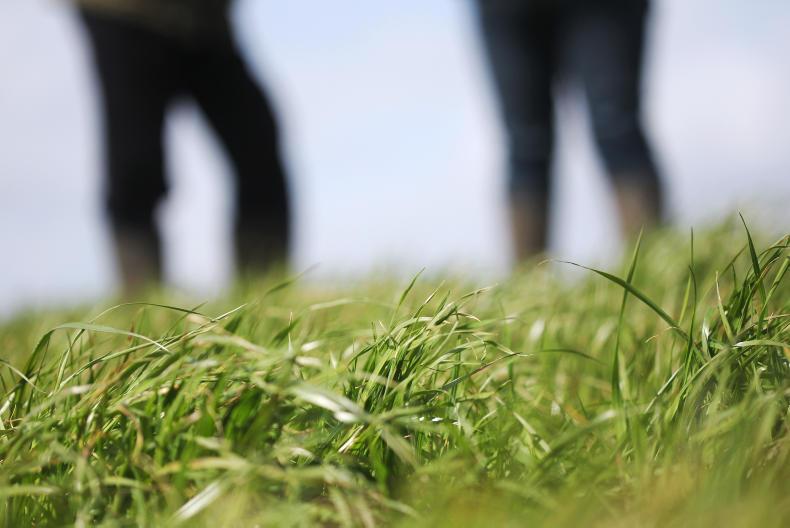This week has seen a lot of the country’s soils fall into a moisture deficit. Once there is greater than 25-30mm of a deficit, it will negatively affect growth rates.
At the moment, a lot of the country’s soils are sitting at a deficit of 50mm, which is going to have a significant effect on growth rates.
A proactive approach needs to be taken. Walking the farm and identifying the reduction in growth early is essential.
The first thing to ensure is that demand doesn’t exceed growth. If so you need to look at increasing supplementation. If you act early enough a few extra kg in the parlour may be enough and shouldn’t affect production.
However, for some, demand may well exceed growth and the options are to graze stronger covers intended for silage or introduce high-quality bales of silage. Both options may slightly affect production but are necessary to keep feed in front of cows.
Growth will only decline until rain comes so when predicting what grass you may have next week, take this into account.
Graze good-quality sward by day and the higher covers by night
Paddocks with covers over 1,000kg DM/ha are still growing at a reasonable rate as the high cover allows the plant to hold the moisture and do better compared with the lower cover.
With this in mind, it’s important to try and maintain pre-grazing yields above 1,200kg DM/ha and 1,300kg DM/ha on farms, allowing the farm to take advantage of the high growth rate with paddocks at these covers.
This is where your extra supplementation will help slow stock down and give paddocks a chance to get closer to the ideal cover of 1,400kg DM/ha.
Grazing
Where the decision is taken to graze a paddock originally intended for silage to help bridge the deficit of grass that may be present or predicted, you should try to minimise the hit to production by staggering the grazing.
Graze good-quality sward by day and the higher covers by night. Pre-mowing these paddocks will also help increase utilisation of the sward.
Nitrogen fertiliser application should continue in a moisture deficit until 25 days have passed without rain.
Avoid topping as it wastes feed available to livestock and will also inhibit regrowth on these paddocks.
Demand can also be reduced by getting rid of excess stock. Dairy farmers who may have maiden heifers on the milking block for breeding should look at moving them off the milking block straight away if grass is running tight.
Read more
2.7t DM grown on PastureBase Ireland farms
This week has seen a lot of the country’s soils fall into a moisture deficit. Once there is greater than 25-30mm of a deficit, it will negatively affect growth rates.
At the moment, a lot of the country’s soils are sitting at a deficit of 50mm, which is going to have a significant effect on growth rates.
A proactive approach needs to be taken. Walking the farm and identifying the reduction in growth early is essential.
The first thing to ensure is that demand doesn’t exceed growth. If so you need to look at increasing supplementation. If you act early enough a few extra kg in the parlour may be enough and shouldn’t affect production.
However, for some, demand may well exceed growth and the options are to graze stronger covers intended for silage or introduce high-quality bales of silage. Both options may slightly affect production but are necessary to keep feed in front of cows.
Growth will only decline until rain comes so when predicting what grass you may have next week, take this into account.
Graze good-quality sward by day and the higher covers by night
Paddocks with covers over 1,000kg DM/ha are still growing at a reasonable rate as the high cover allows the plant to hold the moisture and do better compared with the lower cover.
With this in mind, it’s important to try and maintain pre-grazing yields above 1,200kg DM/ha and 1,300kg DM/ha on farms, allowing the farm to take advantage of the high growth rate with paddocks at these covers.
This is where your extra supplementation will help slow stock down and give paddocks a chance to get closer to the ideal cover of 1,400kg DM/ha.
Grazing
Where the decision is taken to graze a paddock originally intended for silage to help bridge the deficit of grass that may be present or predicted, you should try to minimise the hit to production by staggering the grazing.
Graze good-quality sward by day and the higher covers by night. Pre-mowing these paddocks will also help increase utilisation of the sward.
Nitrogen fertiliser application should continue in a moisture deficit until 25 days have passed without rain.
Avoid topping as it wastes feed available to livestock and will also inhibit regrowth on these paddocks.
Demand can also be reduced by getting rid of excess stock. Dairy farmers who may have maiden heifers on the milking block for breeding should look at moving them off the milking block straight away if grass is running tight.
Read more
2.7t DM grown on PastureBase Ireland farms






 This is a subscriber-only article
This is a subscriber-only article










SHARING OPTIONS: